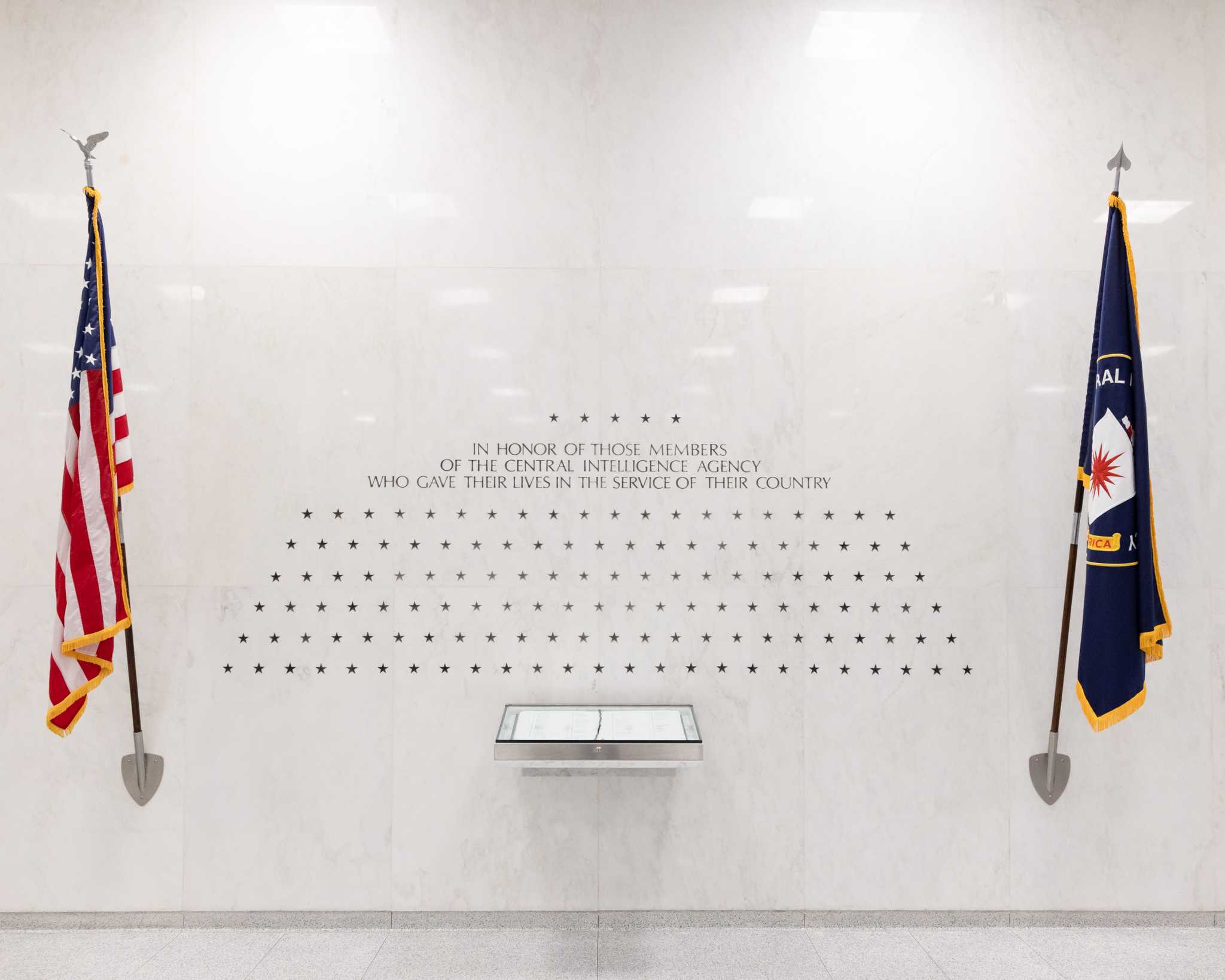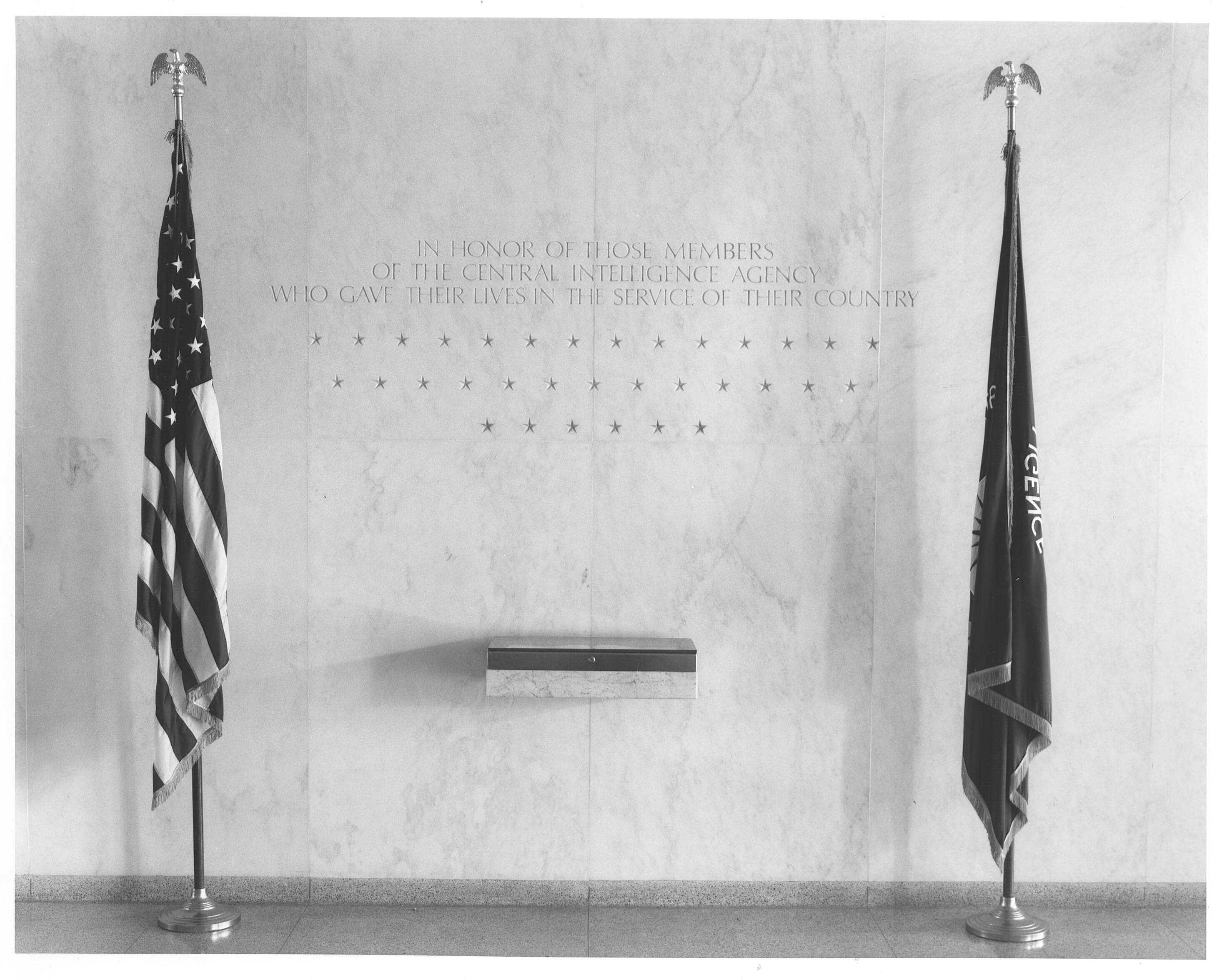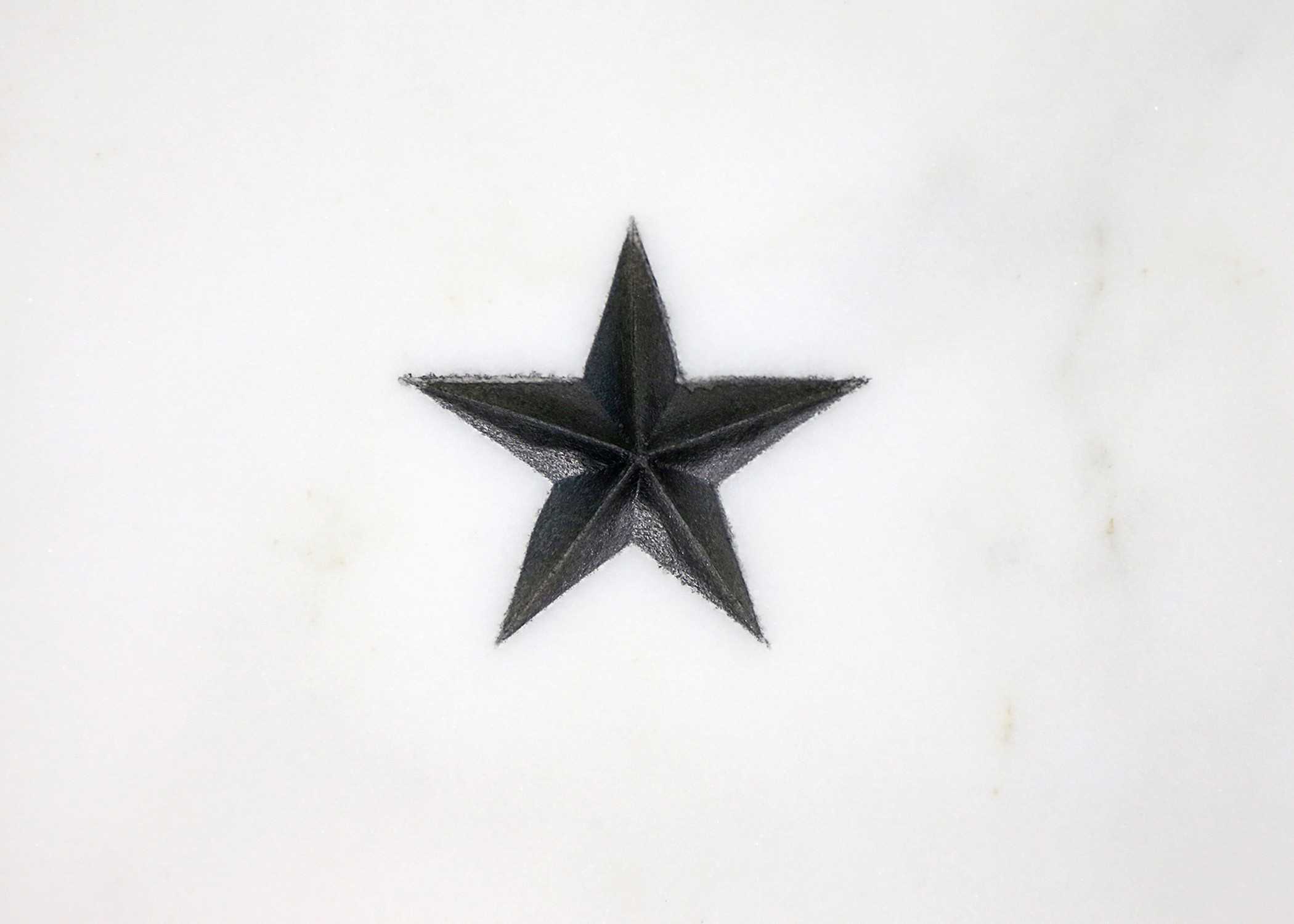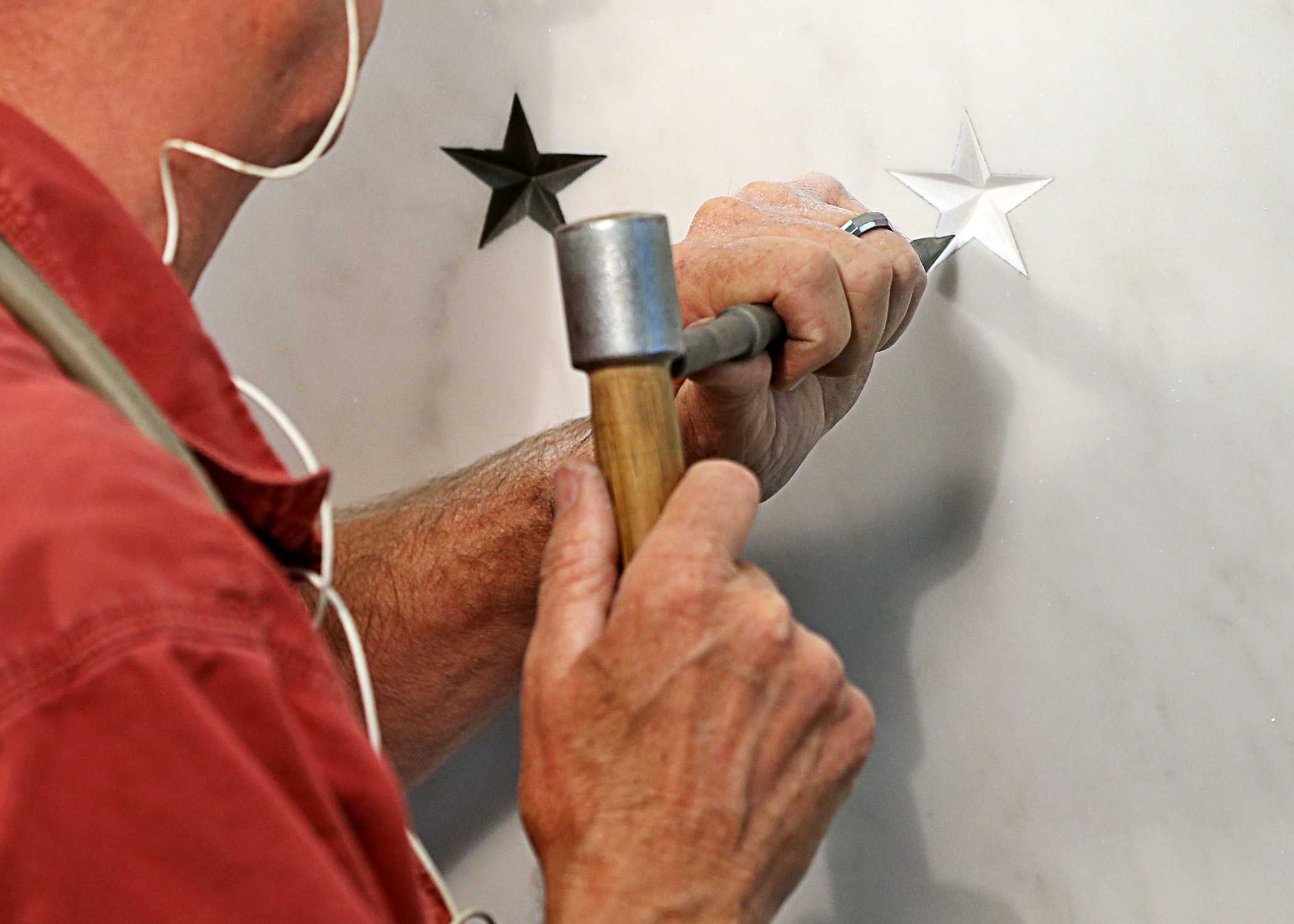Just inside the main entrance of CIA Headquarters in Langley, Virginia is a white marble wall with a field of stars etched into the cold, hard stone. It is the most sacred space on the Agency’s compound.
Each star memorializes a life lost in the line of duty, a sacrifice on behalf of our nation.
The inscription above the constellation reads, “In honor of those members of the Central Intelligence Agency who gave their lives in the service of their country.”
The Memorial Wall was created fifty years ago, in 1974, when 31 stars were chiseled into the marble.

The CIA Memorial Wall, 2024.
How the Wall Came to Be
In February 1973, Agency officers proposed that a memorial plaque be placed at CIA Headquarters to honor employees who had died in Southeast Asia, primarily in Laos and Vietnam. The idea was expanded to recognize all officers who had fallen in the line of duty.
Master Stone Carver Harold Vogel designed the CIA Memorial. Vogel’s goal was to make the memory of the fallen an integral part of the building. His vision of the CIA’s Memorial emphasized the unity of the stars on the Wall, standing as a field.

Earliest known photo of the CIA Memorial Wall, 33 stars.
Vogel’s concept was approved in November 1973; Director William Colby approved the 31 original stars in April 1974.
Three months later, Vogel carved the Memorial. It was done without fanfare. No ceremony was held; no pictures were taken. The stars and inscription simply appeared.
The stars sat in silent commemoration for the next 13 years without ceremony.
In 1986, a counterintelligence officer suggested that a ceremony be held annually in front of the Wall because, “The majority of our employees, particularly the younger generation, are barely aware of the existence or the significance of this memorial.” The officer said this custom would result in “rising morale and pride in our achievements which, in turn, would greatly contribute to our continuing effort to achieve excellence.”
Senior management endorsed the idea, and the first Memorial Ceremony was held in 1987, presided by Deputy Director Robert Gates. It was a simple event, attended by a small number of Agency officers.
Ceremonies that honor the dead are, in truth, for the living. They remind us of our mortality but also celebrate the lives and memories of those we have loved, trusted, and respected. Certainly, we mourn their loss—but we also glory in the knowledge of their extraordinary contribution to our service and to our country.
Deputy Director of Central Intelligence Robert Gates, May 1987
By the time of that first ceremony the number of stars had grown to 50. Now, fifty years later, there are 140 stars chiseled into the Wall.
Who Gets a Star?
The men and women remembered on the Memorial Wall all lost their lives while serving their country in the line of duty. Our fallen represent every aspect of the Agency’s mission, from operations and support officers to analysts and scientists. The men and women come from every Directorate, either as staff officers or contractors, and served in every corner of the world. Some had many years of service, others were young. The youngest died when she was just 21.

A single star from CIA’s Memorial Wall.
Carving the Stars
Master Stone Carver Harold Vogel designed and carved the first stars into the CIA Memorial Wall. The CIA chose Vogel because of his extensive experience—he worked on the National Cathedral, the U.S. Capitol building, and completed all the lettering on the marble walls of The John F. Kennedy Center for the Performing Arts.
Today the stars are carved by Tim Johnston, who learned his craft as an apprentice to Vogel. Johnston watched Vogel carve stars on the Memorial Wall for several years before he was allowed to carve a star with his own hand in 1989.
The Memorial Wall is a bittersweet project for Johnston. He is proud to help recognize CIA’s mission and the sacrifices made by Agency officers on behalf of the nation. Yet each time he must come to CIA, he does so with a heavy heart aware that an officer has fallen.
When Harold Vogel designed the original Wall, it was not intended for the large number of stars that appear today. It is a very sad thought, all those sacrifices.
Tim Johnston, Stone Carver
Johnston uses Vogel’s original 1974 template—which, when not in use, is locked in a safe—to ensure that every star is the same. Each one is first drawn by hand; the carving itself takes about one hour. Each star measures 2¼ inches tall by 2¼ inches wide and half an inch deep; the stars are six inches apart from each other, as are the rows. Johnston uses both a pneumatic air hammer and a chisel to carve out the traced pattern. After he finishes carving the star, he cleans the dust and sprays the star dark gray, which with age, acquires its own patina.

Johnston approaches his task with exceptional care. He describes the experience in his own words: “I only have one shot to carve the star—marble is unpredictable, you can never be sure how it will act—it’s a scary situation. But at the same time, it’s a fantastic thing to do.”
The Book of Honor
The Book of Honor—on display in front of the Memorial Wall at all times—contains the names of employees who died while serving their country. Next to each name is a 23-carat gold leaf star. For reasons of security—to protect intelligence sources and methods—the names of some of those on the Wall must remain secret, even in death. Each of these officers is remembered in the book by a gold star alone.

The Book of Honor displayed below the CIA Memorial Wall.
Part of Vogel’s concept for the Memorial Wall included a display case to house the Book of Honor. The cover of the book, never seen by the public, displays a 22-carat gold embossed Agency seal. Vogel selected a special Moroccan leather that is often used in fine book binding around the world.
The original book was small in size: 25 inches x 9 inches. Sadly, by 2004, the 83rd star had been added to the original book and it was poignantly apparent that a larger book and case were required. The second book is almost double the size of the original, but in all other ways an exact duplicate.
Vogel and Johnston designed and built the current case out of Carrara marble (measuring 36 inches x 22 ½ inches), leaving a resting place for the original book to lie underneath.
The Book of Honor itself is a work of art thanks to the skill of a professional calligrapher—a CIA employee—who writes each name and draws each star by hand. She uses a special dip pen and ink that is reserved exclusively for the book. The gold leaf used for each star is made in France from a hundred-year-old recipe.
When a star is added to the Wall, the Book of Honor is updated concurrently.
Remembering
Over the decades, the Memorial Wall and ceremony have been what their creators hoped they would be—a place of quiet tribute and reflection.
The Wall, and the stories of the people it commemorates, inspire all who carry the mission forward. It is a lasting reminder of their heroism, the risks inherent in the intelligence profession, and every officer’s pledge to put service before self. It affirms CIA’s commitment to the American people.
When you look at the Wall, you see the greatness of CIA. You see the greatness of America. Each of those 140 stars represents an officer unwavering in their commitment to the greater good. Each represents a life that refused to be cowed by our enemies. And each represents a life near and dear to all of us. We will always honor and remember them. And we will always remain devoted to carrying forward their remarkable legacies.
CIA Director William Burns, May 2024
